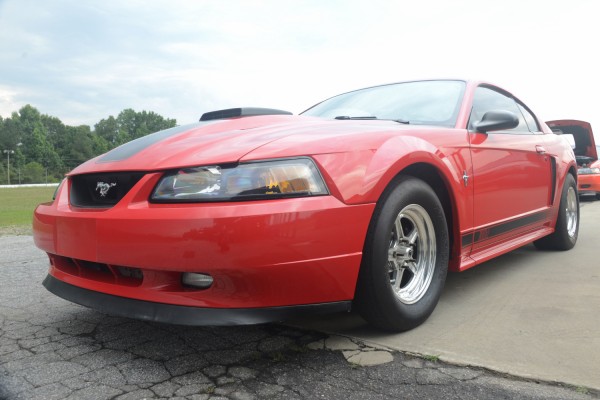In the early spring of 2003, Gary Winter went to his local dealership to buy a pickup truck. On his way to the sales office to complete the truck transaction, he was so taken by the lines of a brand new 4.6L-powered Mustang Mach I that he forgot all about the truck.
Eleven years later, Winter and his Mach I are on the cusp of running nine second quarter miles.
With the exception of the Billet Specialties wheels, the outward appearance of the car has not changed. However, Gary swapped out the 4.6L 4-valve engine for a Ford Racing 5.0L Boss block and stronger internals. Built by MV Performance of Winder, GA, the engine measures 324 cubic inches, uses the factory cylinder heads, and sports a new intake manifold and a BigStuff3 EFI controller. It makes 505 horsepower at the flywheel and can rev to 9,000 rpm. The original five-speed transmission has also been replaced as Winter elected to upgrade to a Tremec TKO 500 with a Quick Time bellhousing. Out back, the 8.8 inch rear end has been upgraded with Moser axles, a Strange spool, and 4.88 ratio gears.
“I was cutting the lights at 7,800 rpm, so we altered the rear gear ratio from 4.56 to 4.88:1,” Winter said. “With the lower gear, we’re aiming to exit the quarter mile at 8,300 or 8,400 rpm. It also eases the loading on the clutch system.”
To handle the car’s 505 horsepower, Winter decided to have a new RAM Powergrip clutch assembly and billet aluminum flywheel installed. The single-disc clutch provides 30 percent greater holding power than a stock clutch and can handle up to 550 horsepower with no appreciable increase in pedal feel. The SFI-approved billet aluminum flywheel is 14 pounds lighter than the factory flywheel. The flywheel’s reduced rotating weight allows the engine to rev quicker, but it still retains enough mass to resist heat distortion that could adversely affect clutch performance. Like most modern performance cars, the Mach I has a traction control system.
MV Performance took us through the installation of the RAM clutch and flywheel assembly. It’s a smart upgrade for any serious street performance or race car.
Parts List
RAM-98882T: Ram Powergrip Clutch Set, Ford 4.6L
RAM-2545: Ram Billet Aluminum Flywheel, Ford 4.6L 4-Valve



















Comments